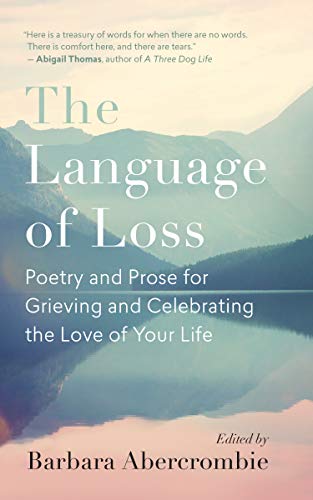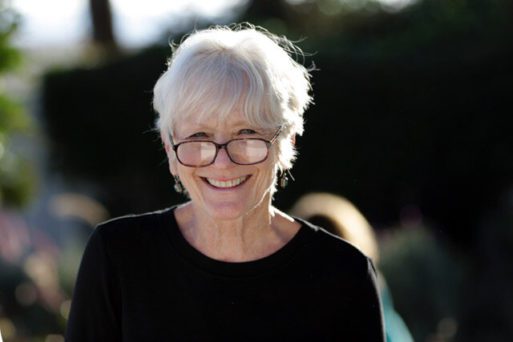 When author Barbara Abercrombie’s husband died, she found the condolence messages of friends and loved ones hollow and meaningless. “My husband had not gone off to a better place as if he was off on holiday,” she writes. “He had not passed like clouds overhead, nor was he my ‘late’ husband as if he had missed a train. I had not lost him as if I’d been careless, and for sure none of it was for the best.” Abercrombie found no comfort in the well meaning words extended to her. Instead, they left her feeling more isolated, angry and alone.
When author Barbara Abercrombie’s husband died, she found the condolence messages of friends and loved ones hollow and meaningless. “My husband had not gone off to a better place as if he was off on holiday,” she writes. “He had not passed like clouds overhead, nor was he my ‘late’ husband as if he had missed a train. I had not lost him as if I’d been careless, and for sure none of it was for the best.” Abercrombie found no comfort in the well meaning words extended to her. Instead, they left her feeling more isolated, angry and alone.
As she moved through her grief, Abercrombie searched for words that gave her actual solace and found them in the writings of dozens of poets and authors who had written about their own journey through grief. Over time, she collected these moving works in an anthology of prose and poetry that she titled “The Language of Loss, Poetry and Prose for Grieving and Celebrating the Love of Your Life.” The collection is diverse and moving, with selections from the writings of the 13th century Persian poet Rumi to Byron and Dickinson to more contemporary offerings from Diane Ackerman, David Wagoner and many more.
Thoughtfully arranged in a way that mirrors an actual grief journey, the selections in “The Language of Loss” begin with tortured words of profound, inconsolable grief, such as Caroline Tufts “Refractory,” which speaks to the impossibility of acceptance, and ends with a lament:
“I will never ask another indulgence
From whatever it is we end by
Calling upon ‘in extremis’. But you do
Not, will not, did not come back
For all the time I pass confounding
assumptions, eluding the rules
for healthy adjustment and getting on
With the rest of it I still cannot accept. “
It then traverses to the often treacherous landscape of “Moving On” and the realization that the loved one is really and truly gone. There are too many wonderful selections in this chapter to choose the “best” one, but one that resonated deeply with me is John Freeman’s “Saudade”
Means nostalgia, I’m told, but also
Nostalgia for what never was. Isn’t it
The same thing? At a cafe
in Rio flies wreathe my glass.
How you would have loved this: the waiter
Sweating his knit shirt dark. Children
Loping, in tiny suits or long shorts, dragging
Toys and towels to the beach. We talk.
Or I talk, and imagine your answer, the heat clouding our view
Here again, grief fashioned in its cruelest tradition:
my imagined you is all I have left of you.

Barbara Abercrombie has published seven books, and teaches in the writers program at UCLA.
The final chapter of “The Language of Love and Loss” is, “Turning,” which speaks to the slow return to some semblance of “normalcy” and the ability to begin to remember a loved one who has died with gratitude and even joy. The selection of prose and poetry in this section is profoundly moving, and ends with Mary Oliver’s incredible tribute to love and resilience, “In Blackwater Woods,” which leaves us with these words:
To live in this world
you must be able
to do three things:
to love what is mortal;
to hold it
against your bones knowing
your own life depends on it;
and, when the time comes to let it go,
to let it go.
In “The Language of Love and Loss,” Barbara Abercrombie has put together an intimate collection of moving works that are meant to be read slowly and gradually integrated into each reader’s understanding of grief and loss. The book would make a thoughtful gift for anyone who is currently grieving a loss or anyone who has ever lost a loved one, no matter how long ago that was. With the holidays approaching, I highly recommend that you add it to your list of gift ideas. And buy a copy for yourself as well. You will pick it up and savor it again and again.

 “The Language of Loss,” Edited by Barbara Abercrombie
“The Language of Loss,” Edited by Barbara Abercrombie


 “Summons” by Aurora Levins Morales
“Summons” by Aurora Levins Morales
 How To Dispose of a Body In Space
How To Dispose of a Body In Space
 AMA Adopts New Policies Expanding Access to Palliative Care
AMA Adopts New Policies Expanding Access to Palliative Care














